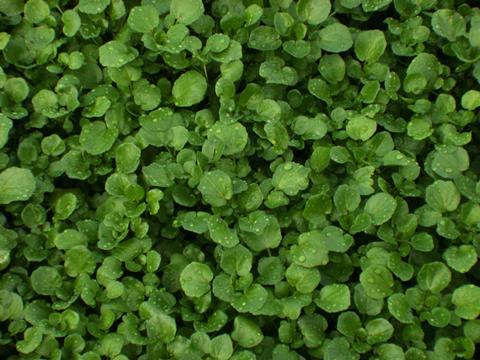As supermarkets ration fresh produce, one salad vegetable remains in plentiful supply thanks to its growing methods, says supplier
With many supermarkets restricting fresh produce sales this month due to import shortages, Spanish watercress remains in good supply thanks to the unique way it is grown, reveals UK supplier The Watercress Company (TWC).

Spain, where many winter vegetables and salad crops are grown for the UK market, has been hit by bad weather and transport disruption resulting in widely reported shortages of fresh produce. Yet Spanish watercress has weathered the storm, the firm says.
”The Watercress Company moved a team of British experts to Jerez in Spain 20 years ago to train farmers there in the skills needed to grow watercress for the UK market. Today, Spain is the second biggest grower of commercial watercress, after the UK,” TWC said in a statement.
”In Spain, using techniques honed over 20 years and a sophisticated system of water recirculation that mimics the natural springs in which watercress is traditionally grown, the growers were able to come through the frosts that affected Jerez in January and February with crops intact,” it said.
”Good supplies of watercress are now readily available, and the UK packing factories that buy watercress and other salad leaves to supply supermarkets, are using more watercress to help supplement the less available leaf varieties in mixed packs. Mono bags of watercress are also sold.”
Watercress is unique among salad leaves as it is grown in specially designed beds in flowing water, not on land. It is this traditional growing method – recognised and protected in 2021 by Traditional Specialised Guaranteed status – that makes all the difference, TWC said.
In the UK, where watercress has been commercially grown since Victorian times, the beds were built where water bubbles up from underground springs and aquifers. It remains at a constant temperature of 10°c, meaning that in times of frost the water doesn’t freeze, while in times of drought the water source is sustained underground. It is the effect of the flowing water created in the Spanish beds through recirculation which provides the same protection, the firm explained.
Tom Amery, MD of The Watercress Company said: “We are very lucky that watercress is so resilient; provided the day temperature is above 14°c it needs neither heating nor protection unlike other salad crops. Demand for watercress is high at the moment because it is able to fill the gap left by other salad leaves whose harvests have been dramatically affected by the weather. We are currently bringing in 32 tonnes of watercress every week but I estimate that 50 tonnes per week are currently being sold in the UK. We rely on our Spanish grown crops to help us maintain all year-round supply of watercress but, at the moment, it is helping to keep the UK in salad - full stop.”



